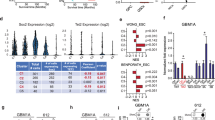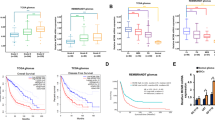Abstract
Solid malignancies contain subsets of multipotent cells that grow as spheres and efficiently propagate tumors in xenograft models, reflecting a stem-like, self-renewing and tumor-propagating phenotype. These cancer ‘stem cells (SCs)’ have been shown to maintain tumor growth, contribute to resistance and drive tumor recurrence. Cancer cell stemness is dynamically influenced by epigenetic mechanisms and differentially regulated coding and noncoding RNAs. How these mechanisms specifically contribute to the generation and/or maintenance of cancer SCs remains unclear. This study identifies a novel epigenetically regulated circuit that integrates microRNA, chromatin remodeling and the reprogramming transcription factor Sox2 to regulate glioblastoma (GBM)-propagating SCs. We show that miR-296-5p expression is repressed in a DNA methylation-dependent manner under conditions that promote GBM cell stemness and that miR-296-5p inhibits GBM cell stemness and their capacity to self-renew as spheres and propagate glioma xenografts in vivo. We show that the chromatin remodeling protein HMGA1 functions as a downstream effector of these biological responses to miR-296-5p and regulates Sox2 expression, a master driver of cell stemness, by modifying chromatin architecture at the Sox2 promoter. These results show for the first time that miR-296-5p inhibits transcriptional mechanisms that support GBM SCs and identify a miR-296-5p:HMGA1:Sox2 axis as a novel regulator of GBM SCs and candidate pathway for targeting therapies directed at depleting tumors of their tumor-propagating stem cell subsets.
This is a preview of subscription content, access via your institution
Access options
Subscribe to this journal
Receive 50 print issues and online access
$259.00 per year
only $5.18 per issue
Buy this article
- Purchase on Springer Link
- Instant access to full article PDF
Prices may be subject to local taxes which are calculated during checkout







Similar content being viewed by others
References
Hanahan D, Weinberg RA . The hallmarks of cancer. Cell 2000; 100: 57–70.
Pardal R, Molofsky AV, He S, Morrison SJ . Stem cell self-renewal and cancer cell proliferation are regulated by common networks that balance the activation of proto-oncogenes and tumor suppressors. Cold Spring Harb Symp Quant Biol 2005; 70: 177–185.
Choi JD, Lee JS . Interplay between epigenetics and genetics in cancer. Genome Inform 2013; 11: 164–173.
Bao S, Wu Q, McLendon RE, Hao Y, Shi Q, Hjelmeland AB et al. Glioma stem cells promote radioresistance by preferential activation of the DNA damage response. Nature 2006; 444: 756–760.
Galli R, Binda E, Orfanelli U, Cipelletti B, Gritti A, De Vitis S et al. Isolation and characterization of tumorigenic, stem-like neural precursors from human glioblastoma. Cancer Res 2004; 64: 7011–7021.
Uchida N, Buck DW, He D, Reitsma MJ, Masek M, Phan TV et al. Direct isolation of human central nervous system stem cells. Proc Natl Acad Sci USA 2000; 97: 14720–14725.
Nguyen LV, Vanner R, Dirks P, Eaves CJ . Cancer stem cells: an evolving concept. Nat Rev Cancer 2012; 12: 133–143.
Singh RP, Shiue K, Schomberg D, Zhou FC . Cellular epigenetic modifications of neural stem cell differentiation. Cell Transplant 2009; 18: 1197–1211.
Wolffe AP . Chromatin remodeling: why it is important in cancer. Oncogene 2001; 20: 2988–2990.
Rajendran G, Shanmuganandam K, Bendre A, Muzumdar D, Goel A, Shiras A . Epigenetic regulation of DNA methyltransferases: DNMT1 and DNMT3B in gliomas. J Neuro-Oncol 2011; 104: 483–494.
Fanelli M, Caprodossi S, Ricci-Vitiani L, Porcellini A, Tomassoni-Ardori F, Amatori S et al. Loss of pericentromeric DNA methylation pattern in human glioblastoma is associated with altered DNA methyltransferases expression and involves the stem cell compartment. Oncogene 2008; 27: 358–365.
Suva ML, Rheinbay E, Gillespie SM, Patel AP, Wakimoto H, Rabkin SD et al. Reconstructing and reprogramming the tumor-propagating potential of glioblastoma stem-like cells. Cell 2014; 157: 580–594.
Marson A, Levine SS, Cole MF, Frampton GM, Brambrink T, Johnstone S et al. Connecting microRNA genes to the core transcriptional regulatory circuitry of embryonic stem cells. Cell 2008; 134: 521–533.
Miyoshi N, Ishii H, Nagano H, Haraguchi N, Dewi DL, Kano Y et al. Reprogramming of mouse and human cells to pluripotency using mature microRNAs. Cell Stem Cell 2011; 8: 633–638.
Anokye-Danso F, Trivedi CM, Juhr D, Gupta M, Cui Z, Tian Y et al. Highly efficient miRNA-mediated reprogramming of mouse and human somatic cells to pluripotency. Cell Stem Cell 2011; 8: 376–388.
Lin SL, Chang DC, Lin CH, Ying SY, Leu D, Wu DT . Regulation of somatic cell reprogramming through inducible mir-302 expression. Nucleic Acids Res 2011; 39: 1054–1065.
Lopez-Bertoni H, Lal B, Li A, Caplan M, Guerrero-Cázares H, Eberhart CG et al. DNMT-dependent suppression of microRNA regulates the induction of GBM tumor propagating phenotype by Oct4 and Sox2. Oncogene 2014; 34: 3994–4004.
Godlewski J, Nowicki MO, Bronisz A, Williams S, Otsuki A, Nuovo G et al. Targeting of the Bmi-1 oncogene/stem cell renewal factor by microRNA-128 inhibits glioma proliferation and self-renewal. Cancer Res 2008; 68: 9125–9130.
Li Y, Guessous F, Zhang Y, Dipierro C, Kefas B, Johnson E et al. MicroRNA-34a inhibits glioblastoma growth by targeting multiple oncogenes. Cancer Res 2009; 69: 7569–7576.
Silber J, Lim DA, Petritsch C, Persson AI, Maunakea AK, Yu M et al. miR-124 and miR-137 inhibit proliferation of glioblastoma multiforme cells and induce differentiation of brain tumor stem cells. BMC Med 2008; 6: 14.
Xia H, Cheung WK, Ng SS, Jiang X, Jiang S, Sze J et al. Loss of brain-enriched miR-124 microRNA enhances stem-like traits and invasiveness of glioma cells. J Biol Chem 2012; 287: 9962–9971.
Sato F, Tsuchiya S, Meltzer SJ, Shimizu K . MicroRNAs and epigenetics. FEBS J 2011; 278: 1598–1609.
Baylin SB, Ohm JE . Epigenetic gene silencing in cancer—a mechanism for early oncogenic pathway addiction? Nat Rev Cancer 2006; 6: 107–116.
Li Y, Laterra J . Cancer stem cells: distinct entities or dynamically regulated phenotypes? Cancer Res 2012; 72: 576–580.
Son MJ, Woolard K, Nam DH, Lee J, Fine HA . SSEA-1 is an enrichment marker for tumor-initiating cells in human glioblastoma. Cell Stem Cell 2009; 4: 440–452.
Lewis BP, Burge CB, Bartel DP . Conserved seed pairing, often flanked by adenosines, indicates that thousands of human genes are microRNA targets. Cell 2005; 120: 15–20.
Esquela-Kerscher A, Slack FJ . Oncomirs—microRNAs with a role in cancer. Nat Rev Cancer 2006; 6: 259–269.
Reeves R, Beckerbauer L . HMGI/Y proteins: flexible regulators of transcription and chromatin structure. Biochim Biophys Acta 2001; 1519: 13–29.
Shah SN, Kerr C, Cope L, Zambidis E, Liu C, Hillion J et al. HMGA1 reprograms somatic cells into pluripotent stem cells by inducing stem cell transcriptional networks. PLoS One 2012; 7: e48533.
Cleynen I, Van de Ven WJ . The HMGA proteins: a myriad of functions (Review). Int J Oncol 2008; 32: 289–305.
Robson JE, Eaton SA, Underhill P, Williams D, Peters J . MicroRNAs 296 and 298 are imprinted and part of the GNAS/Gnas cluster and miR-296 targets IKBKE and Tmed9. RNA 2012; 18: 135–144.
Shivapurkar N, Mikhail S, Navarro R, Bai W, Marshall J, Hwang J et al. Decrease in blood miR-296 predicts chemotherapy resistance and poor clinical outcome in patients receiving systemic chemotherapy for metastatic colon cancer. Int J Colorectal Dis 2013; 28: 887.
Hong L, Han Y, Zhang H, Li M, Gong T, Sun L et al. The prognostic and chemotherapeutic value of miR-296 in esophageal squamous cell carcinoma. Ann Surg 2010; 251: 1056–1063.
Lee KH, Lin FC, Hsu TI, Lin JT, Guo JH, Tsai CH et al. MicroRNA-296-5p (miR-296-5p) functions as a tumor suppressor in prostate cancer by directly targeting Pin1. Biochim Biophys Acta 2014; 1843: 2055–2066.
Wei JJ, Wu X, Peng Y, Shi G, Basturk O, Yang X et al. Regulation of HMGA1 expression by microRNA-296 affects prostate cancer growth and invasion. Clin Cancer Res 2011; 17: 1297–1305.
Fusco A, Fedele M . Roles of HMGA proteins in cancer. Nat Rev Cancer 2007; 7: 899–910.
Lund T, Holtlund J, Fredriksen M, Laland SG . On the presence of two new high mobility group-like proteins in HeLa S3 cells. FEBS Lett 1983; 152: 163–167.
Xu Y, Sumter TF, Bhattacharya R, Tesfaye A, Fuchs EJ, Wood LJ et al. The HMG-I oncogene causes highly penetrant, aggressive lymphoid malignancy in transgenic mice and is overexpressed in human leukemia. Cancer Res 2004; 64: 3371–3375.
Ben-Porath I, Thomson MW, Carey VJ, Ge R, Bell GW, Regev A et al. An embryonic stem cell-like gene expression signature in poorly differentiated aggressive human tumors. Nat Genet 2008; 40: 499–507.
Somervaille TC, Matheny CJ, Spencer GJ, Iwasaki M, Rinn JL, Witten DM et al. Hierarchical maintenance of MLL myeloid leukemia stem cells employs a transcriptional program shared with embryonic rather than adult stem cells. Cell Stem Cell 2009; 4: 129–140.
Belton A, Gabrovsky A, Bae YK, Reeves R, Iacobuzio-Donahue C, Huso DL et al. HMGA1 induces intestinal polyposis in transgenic mice and drives tumor progression and stem cell properties in colon cancer cells. PLoS One 2012; 7: e30034.
Catez F, Ueda T, Bustin M . Determinants of histone H1 mobility and chromatin binding in living cells. Nat Struct Mol Biol. 2006; 13: 305–310.
Pandita A, Aldape KD, Zadeh G, Guha A, James CD . Contrasting in vivo and in vitro fates of glioblastoma cell subpopulations with amplified EGFR. Genes Chromosomes Cancer 2004; 39: 29–36.
Glas M, Rath BH, Simon M, Reinartz R, Schramme A, Trageser D et al. Residual tumor cells are unique cellular targets in glioblastoma. Ann Neurol 2010; 68: 264–269.
Messeguer X, Escudero R, Farre D, Núñez O, Martínez J, Albà MM . PROMO: detection of known transcription regulatory elements using species-tailored searches. Bioinformatics 2002; 18: 333–334.
Li Y, Lal B, Kwon S, Fan X, Saldanha U, Reznik TE et al. The scatter factor/hepatocyte growth factor: c-met pathway in human embryonal central nervous system tumor malignancy. Cancer Res 2005; 65: 9355–9362.
Acknowledgements
This work was supported by grants from the American Brain Tumor Association (to HL-B), and the United States NIH Grants R01NS073611 (to JL) and R01NS070024 (to AQ-H).
Author information
Authors and Affiliations
Corresponding author
Ethics declarations
Competing interests
Dr Laterra’s and Dr Quinones-Hinojosa’s work has been funded by the NIH.
Additional information
Supplementary Information accompanies this paper on the Oncogene website
Rights and permissions
About this article
Cite this article
Lopez-Bertoni, H., Lal, B., Michelson, N. et al. Epigenetic modulation of a miR-296-5p:HMGA1 axis regulates Sox2 expression and glioblastoma stem cells. Oncogene 35, 4903–4913 (2016). https://doi.org/10.1038/onc.2016.22
Received:
Revised:
Accepted:
Published:
Issue Date:
DOI: https://doi.org/10.1038/onc.2016.22
This article is cited by
-
Nucleic acid drug vectors for diagnosis and treatment of brain diseases
Signal Transduction and Targeted Therapy (2023)
-
Systems Medicine for Precise Targeting of Glioblastoma
Molecular Biotechnology (2023)
-
HMGA1 stimulates MYH9-dependent ubiquitination of GSK-3β via PI3K/Akt/c-Jun signaling to promote malignant progression and chemoresistance in gliomas
Cell Death & Disease (2021)
-
Regulation of DNA methylation machinery by epi-miRNAs in human cancer: emerging new targets in cancer therapy
Cancer Gene Therapy (2021)
-
MicroRNA-296-5p inhibits cell metastasis and invasion in nasopharyngeal carcinoma by reversing transforming growth factor-β-induced epithelial–mesenchymal transition
Cellular & Molecular Biology Letters (2020)



